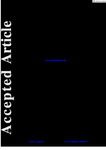Characterizing Hydration of the Ocean Crust Using Shortwave Infrared Microimaging Spectroscopy of ICDP Oman Drilling Project Cores
Date
2021-11-01Author
Subject
Metadata
Show full item recordAbstract
<jats:title>Abstract</jats:title><jats:p>Although ocean crust covers over 60% of Earth's surface, the processes that form, cool, and alter the ocean crust are not completely understood. We utilize shortwave infrared micro‐imaging spectroscopy of ∼1.2 km of rock cored by the International Continental Scientific Drilling Program's Oman Drilling Project to quantify hydration of basaltic dikes and gabbros from the Samail ophiolite as a function of depth, mineralogy and deformation. We develop a regression (<jats:italic>R</jats:italic><jats:sup>2</jats:sup> = 0.66) between area of the ∼1,350–1,650 nm OH/H<jats:sub>2</jats:sub>O absorption and measurements of loss on ignition of samples and apply this relationship to generate quantitative ∼250 μm/pixel hydration maps for all cores. The lowest mean hydration is observed in the most pervasively altered dike‐gabbro boundary (GT3A, H<jats:sub>2</jats:sub>O<jats:sub>mean</jats:sub> = 2.1 ± 1.6 wt%), consistent with the low H<jats:sub>2</jats:sub>O content of the dominant alteration minerals, amphibole and epidote. The highest H<jats:sub>2</jats:sub>O content occurs in deeper foliated and layered gabbros (GT2A, H<jats:sub>2</jats:sub>O<jats:sub>mean</jats:sub> = 3.2 ± 3.0 wt%) and layered gabbros (GT1A, H<jats:sub>2</jats:sub>O<jats:sub>mean</jats:sub> = 2.8 ± 3.1 wt%). The greater prevalence with depth of zeolite alteration as opposed to lower wt% H<jats:sub>2</jats:sub>O amphibole at shallow stratigraphic depths, as well as the occurrence of zones of intensive hydration associated with fault zones (H<jats:sub>2</jats:sub>O<jats:sub>mean</jats:sub> = 5.7 ± 4.0 wt%) lead to greater hydration of the lower ocean crust. This new approach provides an objective quantification of hydration in these cores, enabling an improved understanding of quantities and characteristics of ocean crust hydration. It highlights the importance of specific phases and faulting in controlling hydration, which has implications for ocean crust cooling, rheological properties, and the role of alteration in global biogeochemical cycling.</jats:p>
Publisher
Journal
Volume
Issue
Number
Recommended, similar items
The following license files are associated with this item:


